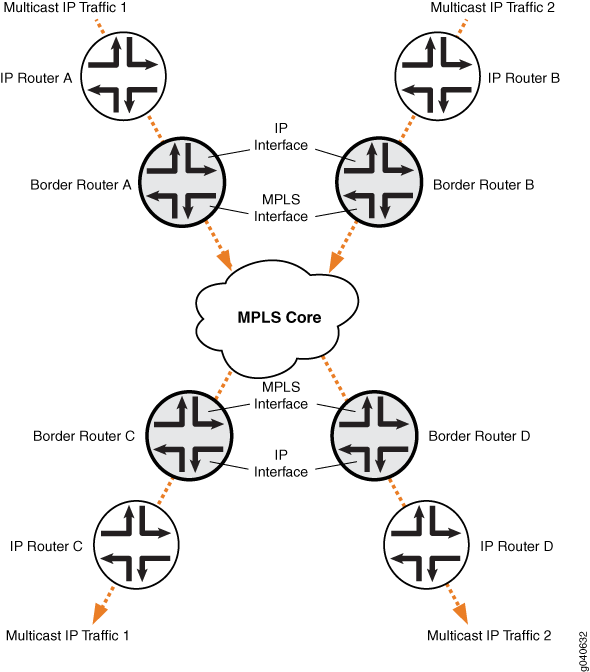The routing instance type mpls-internet-multicast uses ingress replication provider tunnels to carry IP multicast
data between routers through an MPLS cloud, enabling a faster path
for multicast traffic between sender and receiver routers in large-scale
implementations.
The mpls-internet-multicast routing instance is a non-forwarding
instance used only for control plane procedures; it does not support
any interface configurations. Only one mpls-internet-multicast routing instance can be defined for a logical system. All
multicast and unicast routes used for Internet multicast are associated
only with the master instance (inet.0), not with the routing instance.
Each router participating in Internet multicast must be configured
with BGP MPLS-based Internet multicast for control plane procedures
and with ingress replication for the data provider tunnel, which forms
a full mesh of MPLS point-to-point LSPs. The ingress replication tunnel
can be selective or inclusive, matching the configuration of the provider
tunnel in the routing instance.
The topology consists of routers on the edge of the IP multicast
domain that have a set of IP interfaces and a set of MPLS core-facing
interfaces, see Figure 1. Internet multicast
traffic is carried between the IP routers, through the MPLS cloud,
using ingress replication tunnels for the data plane and a full-mesh
IGBP session for the control plane.
The mpls-internet-multicast routing
instance type is configured for the default master instance on each
router to support Internet multicast over MPLS. When using PIM as
the multicast protocol, the mpls-internet-multicast configuration
statement is also included at the [edit protocols pim] hierarchy
level in the master instance. This creates a pseudo-interface that
associates PIM with the mpls-internet-multicast routing
instance.
When a new destination needs to be added to the ingress replication
provider tunnel, the resulting behavior differs depending on how the
ingress replication provider tunnel is configured:
create-new-ucast-tunnel—When this statement
is configured, a new unicast tunnel to the destination is created,
and is deleted when the destination is no longer needed. Use this
mode for RSVP LSPs using ingress replication.
label-switched-path-template
(Multicast)—When this statement is configured,
an LSP template is used for the for the point-to-multipoint LSP for
ingress replication.
Figure 1: Internet
Multicast Topology
Example: Configure Internet Multicast Using
Ingress Replication Tunnels
This example configures VPN-B with the instance type mpls-internet-multicast. This example also uses PIM for the multicast protocol.
- Configure the routing instance type for VPN-B as
mpls-internet-multicast:user@host# set routing-instances VPN-B instance-type mpls-internet-multicast
- Configure the ingress replication provider tunnel to create
a new unicast tunnel each time an application requests to add a destination:
user@host# set routing-instances VPN-B provider-tunnel ingress-replication
create-new-ucast-tunnel
- Configure the point-to-point LSP to use the default template
settings.
user@host# set routing-instances VPN-B provider-tunnel ingress-replication
label-switched-path label-switched-path-template default-template
- Configure the ingress replication provider tunnel to be
selective:
user@host# set routing-instances VPN-B provider-tunnel selective
group 203.0.113.1/24 source 192.168.195.145/32 ingress-replication
label-switched-path
- Configure MVPN protocol in the routing instance:
user@host# set routing-instances VPN-B protocols mvpn
- Commit the configuration:
- Use show command to verify the instance has been created:
user@host# run show mvpn instance VPN-B
MVPN instance:
Legend for provider tunnel I-P-tnl -- inclusive provider tunnel S-P-tnl -- selective provider tunnel
Legend for c-multicast routes properties (Pr)
DS -- derived from (*, c-g) RM -- remote VPN route
Instance : VPN-B
MVPN Mode : SPT-ONLY
Provider tunnel: I-P-tnl:INGRESS-REPLICATION:MPLS Label 18:10.255.245.6
Neighbor I-P-tnl
10.255.245.2 INGRESS-REPLICATION:MPLS Label 22:10.255.245.2
10.255.245.7 INGRESS-REPLICATION:MPLS Label 19:10.255.245.7
C-mcast IPv4 (S:G) Ptnl St
192.168.195.145/32:203.0.113.1/24 INGRESS-REPLICATION:MPLS Label
18:10.255.245.6 RM
- Add the
mpls-internet-multicast configuration
statement under the [edit protocols pim] hierarchy level
in the master instance:user@host# set protocols pim mpls-internet-multicast
- Commit the configuration:
- Use
show ingress-replication mvpn command to
verify configuration settings:user@host# run show ingress-replication mvpn
Ingress Tunnel: mvpn:1l
Application: MVPN
Unicast tunnels
Leaf Address Tunnel-type Mode State
10.255.245.2 P2P LSP New Up
10.255.245.4 P2P LSP New Up
Ingress Tunnel: mvpn:2
Application: MVPN
Unicast tunnels
Leaf Address Tunnel-type Mode State
10.255.245.2 P2P LSP Existing Up
- Use this if you want to configure the ingress replication
provider tunnel to be inclusive:
user@host# set routing-instances VPN-B provider-tunnel ingress-replication
create-new-ucast-tunnel
user@host# set routing-instances VPN-B provider-tunnel ingress-replication
label-switched-path label-switched-path-template default-template
- Use show mvpn instance command to verify tunnel is inclusive:
user@host# run show mypn instance VPN-B
MVPN instance:
Legend for provider tunnel
I-P-tnl -- inclusive provider tunnel S-P-tnl -- selective provider tunnel
Legend for c-multicast routes properties (Pr)
DS -- derived from (*, c-g) RM -- remote VPN route
Instance : VPN-A
MVPN Mode : SPT-ONLY
Provider tunnel: I-P-tnl:INGRESS-REPLICATION:MPLS Label 18:10.255.245.6
Neighbor I-P-tnl
10.255.245.2 INGRESS-REPLICATION:MPLS Label 22:10.255.245.2
10.255.245.7 INGRESS-REPLICATION:MPLS Label 19:10.255.245.7
C-mcast IPv4 (S:G) Ptnl St
192.168.195.145/32:203.0.113.1/24 INGRESS-REPLICATION:MPLS Label 18:10.255.245.6 RM

